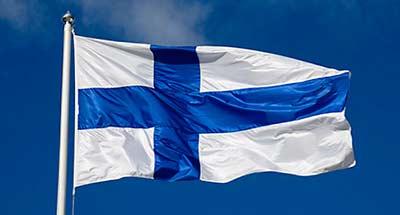
Some people like to visit Helsinki at the peak of summer when it shimmers in sunlight nearly ‘round the clock. Others find the dead of winter a delight because of how the city glows with lights reflected off the snow and ice that covers every surface.
But then there's the "dark month" of November when the hours of daylight are few, but no snow or ice reflect any artificial lights. It may well be a "dark month" compared with the rest of the year, but the charm of the city still shines through and there aren't crowds of tourists to battle.
This became clear when we began our tour with a visit to Senate Square - the massive plaza created by architect Carl Ludvig Engel after Sweden lost its Finnish possessions to Russia in 1809. On this morning it was practically empty.
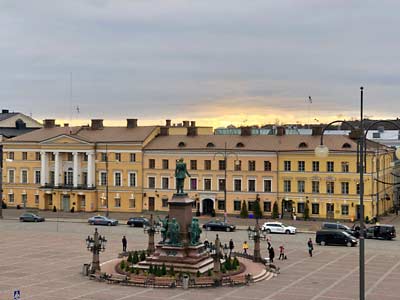
Nearly empty Senate Square
Russia didn't try to turn Finland into part of Russia. Rather, since what it really wanted was a buffer state, it decided to "let the Finns be Finns." Since more Finns were Lutherans than members of the Russian Orthodox Church, Engel placed a monumental Lutheran Cathedral on the highest hill to dominate the square and the city.
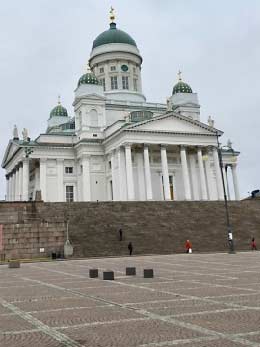
The Lutheran Cathedral dominates the square
Of course, when the Tsar finally came to see what had been created, he was disturbed that the Russian Orthodox Cathedral Engel had built wasn't nearly as grand as the Lutheran Church. So, he commanded a bigger one be constructed on a neighboring hill. Both now dominate the skyline at the harbor side.
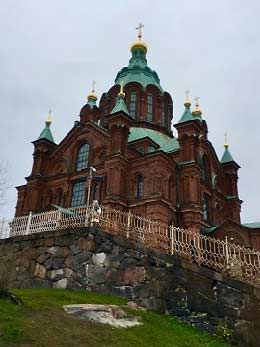
The Orthodox Cathedral is on a neighboring hill
Senate Square itself is flanked by Engel's buildings for the Finnish Senate and for Helsinki University. They may seem to be architectural bookends, but look closely at the columns - the University has Ionic capitals as befits an academic building, while the Senate sports Corinthian capitals reminiscent of the public buildings of the Roman empire.
| |
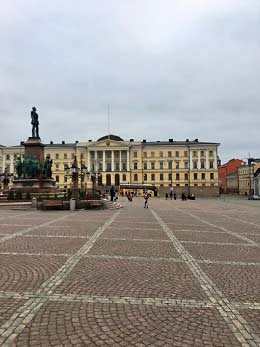 |
|
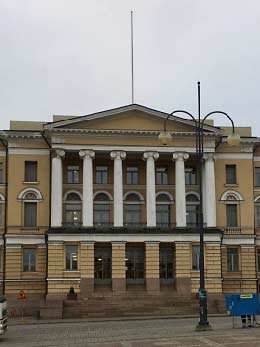 |
|
| |
The Old Finnish Senate Building with Corinthian capitals |
|
Helsinki University with Ionic capitals |
|
In the middle of the square is a huge statue by Finnish sculptor Walter Magnus Runenberg of a Tsar...but not the Tsar who was the first Russian Grand Duke of Finland: Alexander I. This statue is of his nephew, Alexander II, who is known as "The Liberator" for his emancipation of Russian serfs in 1861.
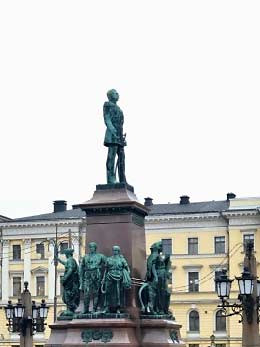
Tsar Alexander II stands in Senate Square
Wander down to the harbor with the Orthodox Cathedral hovering above you and find a very Finnish feature: a sauna. Adjacent to the Sauna is a pier with a swimming pool and an opening into harbor water that is kept free (or fairly free) of ice for the sauna customers who want to take a dip to cool off following their confinement in very hot boxes.
| |
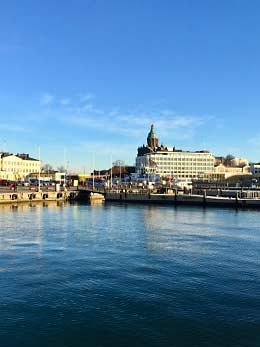 |
|
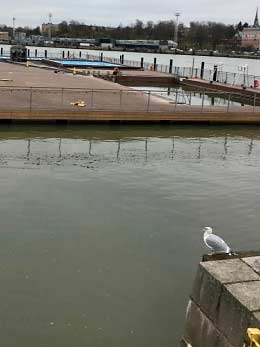 |
|
| |
Helsinki's harbor wasn't iced over in November |
|
Cold water for a post-sauna dip
|
|
The harbor is flanked by other public buildings including City Hall, the President's Residence and a Market Hall offering indoor stalls of coffee, pastries, groceries and the like. But you needn't go indoors for such things. There's a thriving outdoor market in the aptly named "Market Square" which operates even in the coldest months.
| |
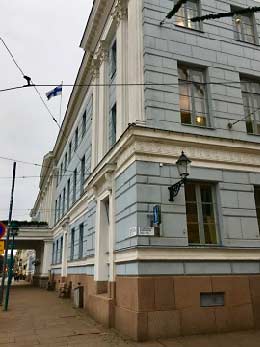 |
|
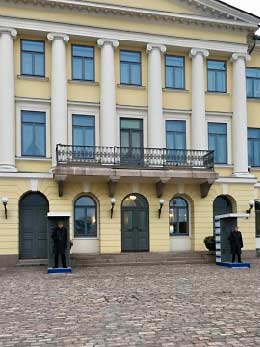 |
|
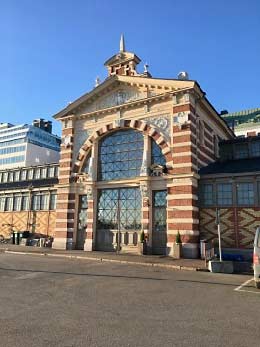 |
|
| |
Helsinki's City Hal |
|
Finnish President's residence |
|
Brick market near Market Square |
|
| |
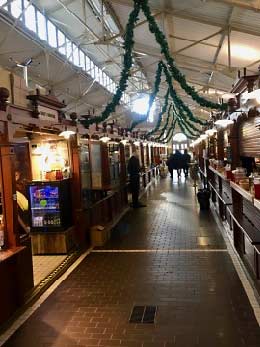 |
|
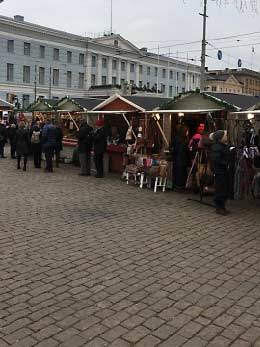 |
|
| |
Inside the brick market is warm and protected |
|
The Finns seem to prefer the outdoor market stalls |
|
The better choice for coffee at this point in the tour is the Kappeli Café, better known to the locals as "The Coffee Chapel." It has been serving coffee here at the foot of the Esplanade Park since 1867. Today, it is but only one of the impressive buildings that flank the park.
| |
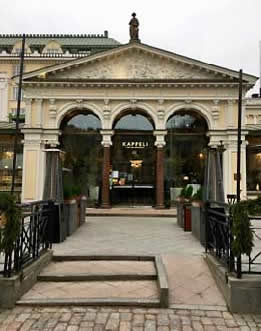 |
|
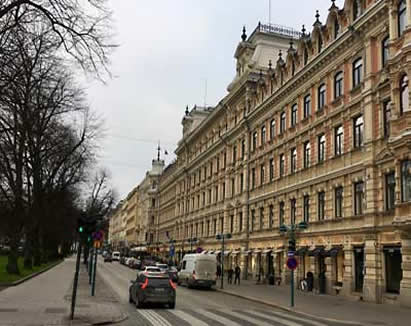 |
|
| |
Best place for coffee at the foot of the Esplanade |
|
Grand buildings flank the Esplanade Park
|
|
At the other end of the Esplanade Park is the Swedish Theater - yes, Swedish! After all, Finland was once a Swedish possession and even today the country is officially bilingual. You see street signs in both languages on every corner.
There has been a theater on this site since 1827, but the current building dates "only" from 1866. It doesn't look that old, however, as it was renovated in 1935 and its exterior changed from neoclassical style to something more functional (and drab).
The interior still reflects sumptuousness however, and the productions of the Svenska Teatern are first rate. They include plays and musicals and provide simultaneous translations in a number of languages via hand-held text readers. When we attended the visually spectacular and sonically rich production of the musical Chess, we could follow Tim Rice's English lyrics while they were sung in Swedish to the melodies of ABBA's Benny Andersson and Björn Ulvaeus.
| |
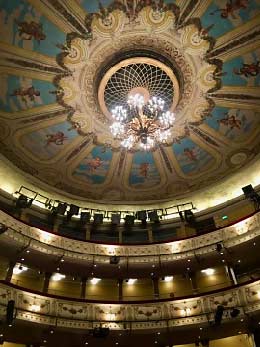 |
|
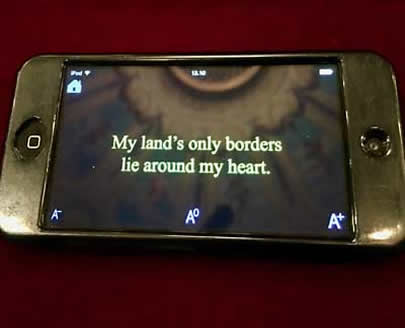 |
|
| |
The sumptuous interior of the Swedish Theatre |
|
Tim Rice's lyrics shown in English on the text reader
|
|
Finns are a soft-spoken lot and they seem to value peace, quiet and solitude. As a result, some seem to find the volume level of modern musicals a bit troublesome, so the theater thoughtfully provides free earplugs for those who want to reduce the volume in their own ears.
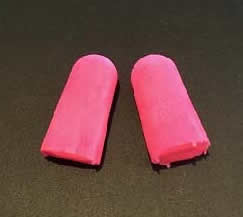
Not everyone wants the same volume
We didn't find earplugs at the Opera though. The Finnish National Opera is housed in a contemporary venue seating 1,300 with all the modern facilities to present huge productions of classic and modern operas. During our visit we caught director Jahannes Erath's staging of Offenbach's The Tales of Hoffman with huge settings by Heike Scheele. The production uses all of the hall's capabilities including placing cast members and even choruses in the boxes of the balcony. Spectacle is obviously a specialty.
| |
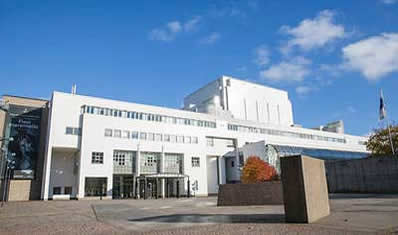 |
|
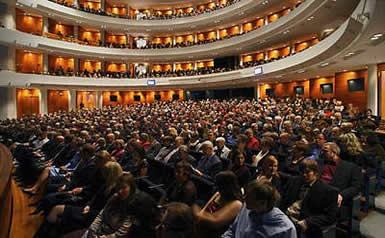 |
|
| |
Helsinki Opera House exterior
photo By Mirka Kleemola |
|
Helsinki Opera House interior
photo by Heikki Tuuli |
|
For devotees of orchestral music, the Musiikkitalo, a multi-venue Music Center that opened in 2011, is the place to go. It houses two major symphony orchestras.
The Helsinki Philharmonic Orchestra is a superb company of over 100 musicians that calls itself "The Orchestra of Sibelius." It is a well-earned title given that between 1892 and 1923 this orchestra premiered almost all of the symphonies of Finland's greatest composer, Jean Sibelius.
Sharing the hall is the Finnish Radio Symphony Orchestra, which is operated by the Finnish Broadcasting Company.
The 1,700-seat concert hall is of the modern "vinyard" style where the audience surrounds the orchestra in seating sections that all but hang from the walls. The resulting acoustics remove some of the directionality found in classically designed halls, resulting in a feeling that you are in the music rather than the music coming at you from a specific space.
| |
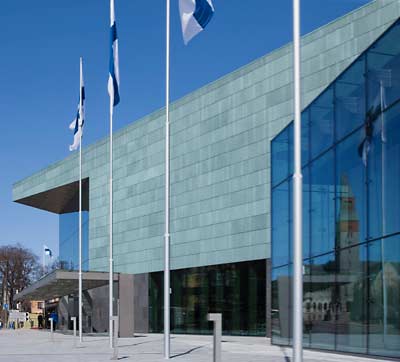 |
|
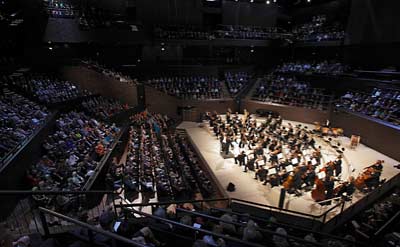
|
|
| |
Musiikkitalo exterior photo by Arno Chapelle |
|
Musiikkitalo's concert hall photo by Heikki Tuuli |
|
Helsinki offers a seemingly never-ending collection of museums in buildings old, new and in between. The Design Museum is housed in a former school building from the nineteenth century. Another museum in a nineteenth century building is the Fire Museum devoted to the history of Finnish first responders. It is located in a rescue station built in 1891 with a lookout tower soaring nearly 150 feet above the city. The tower was tall not only to provide an observation platform to look for fires; it provided an indoor space to hang hoses to dry so they wouldn't freeze during Helsinki's long hard winter.
| |
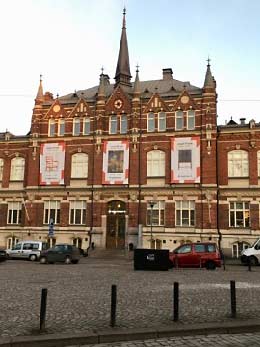 |
|
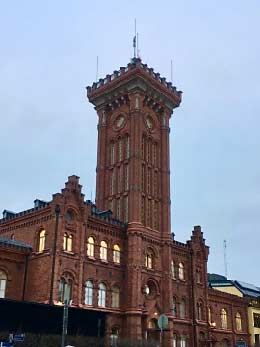 |
|
| |
The Helsinki Design Museum
|
|
Helsinki's fire museum
|
|
More modern museum facilities include the massive Kiasma built at the end of the twentieth century to a design by American architect Steven Holl, and the more whimsical Amos Rex museum across the street which sports huge hill-like skylights surfacing in what once was a parking lot.
| |
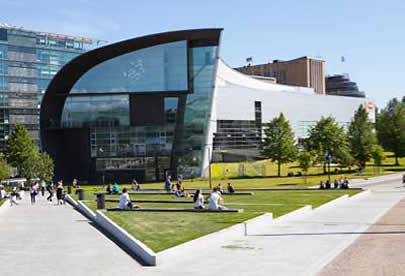 |
|
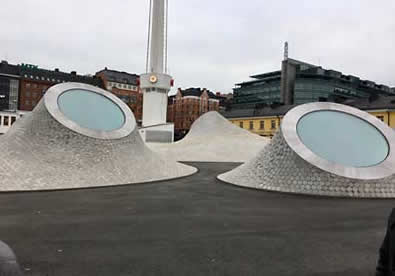 |
|
| |
Photo courtesy Finnish National Gallery / Pirje Mykkänen
|
|
The skylights of the Amos Rex museum rise from a former parking lot
|
|
Helsinki is build on a bedrock foundation called the Fennoscandian Shield which means that underneath a very shallow layer of soil you find dense granite. To build under that shallow layer requires blasting away solid granite. The best illustration of this happens to be a church - the Temppeliaukio Church known far and wide as the "Rock Church." Architect brothers Timo and Tuomo Suomalainen came up with the idea of blasting a space in the rock of a hill and then capping it with a copper dome supported by concrete beams with glass spacers so that the dome appears to hover over the congregation. The effect is unique as artificial light creates a striking altar space. The acoustical properties of the church are so clear and clean that there are musical performances in the chapel almost every day.
| |
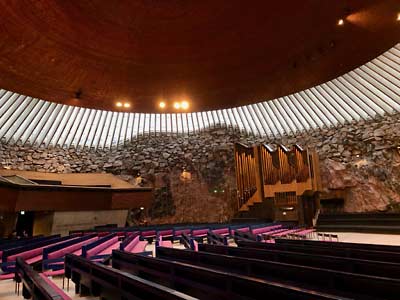 |
|
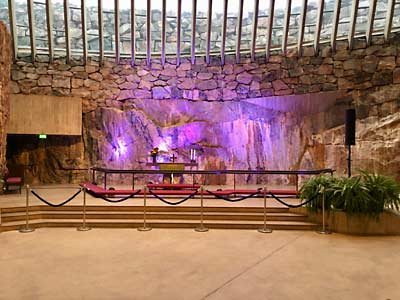 |
|
| |
A church blasted out of solid rock |
|
The "Rock Church" altar |
|
Helsinki is also a city filled with outdoor art - specifically, sculpture. It is to be found around every corner. Indeed, the Helsinki Art Museum has an online database with information on some 500 sculptural works on display al fresco.
Some have special stories to be shared. For example, in the Esplanade Park you will find a monument to Zachris Topelius, a Finnish poet, author and journalist who wrote in Swedish and who was the Rector of the University of Helsinki. It features two naked women: one representing "Fact" and one "Fable." Many Topelius fans were not pleased by such a stylized, allegorical (and naked) memorial, so they raised money to construct another one. Theirs, a statue of him with a group of fully clothed children, can be found in a small park in front of the Design Museum.
| |
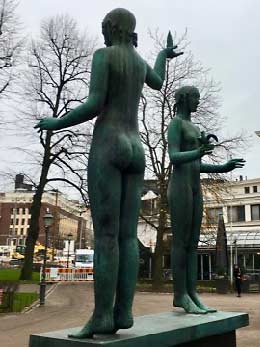 |
|
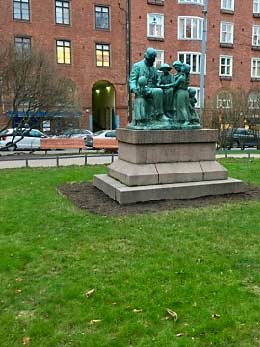 |
|
| |
Memorial to Topelius in the Esplanade |
|
The other memorial to Topelius
|
|
Another sculptural pair flank a pool in the Esplanade Park that, in November, is dry - but the frolicking fish, mermaid and children don't seem to mind. The bronzes are by Viktor Jansson.
| |
The playful bronzes of Viktor Jansson |
|
Not all the art is so representational. You may discover a cubist or abstract sculpture around any corner. Eila Hiltunen's 2006 "Gone Heroes" in front of the Pikkuparlamentti (small parliament building) celebrates the centennial of the parliament and universal suffrage/full political rights for women. Björn Weckström's strikingly vertical "The Whistling City-Dweller," on the other hand, is the artist's effort to capture the "easygoing and humorous attitude to life of the people of Helsinki."
| |
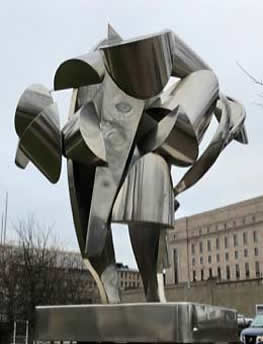 |
|
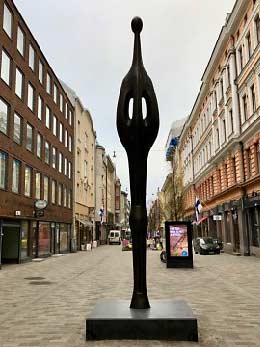 |
|
| |
Hiltunen's Gone Heroes |
|
Weckström's Whistling City-Dweller |
|
Two sculptures are probably the most famous, or at least the most photographed. Ville Vallgren's "Daughter of the Baltic" wore a wreath the day we passed by. The most photographed, I'm told, however, is the statue of three smiths (representing the importance of hard work and cooperation among Finnish laborers) by Felix Nylund. It stands in the center of the shopping district.
| |
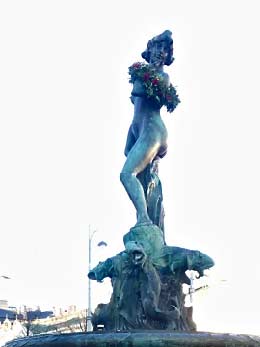 |
|
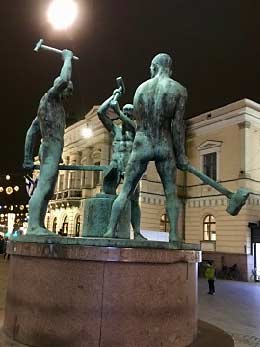 |
|
| |
Vallgren's "Daughter of the Baltic" |
|
Nylund's "Three Smiths" |
|
November may well be a "dark month" in Helsinki. But viewed during the few hours of daylight or in the lights of evening, it is a city of charm and delight.
|